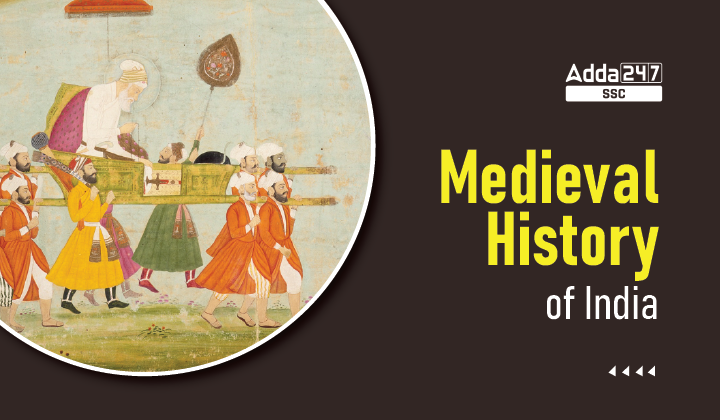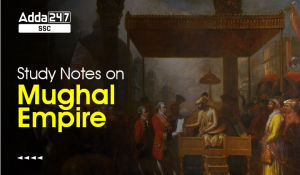Medieval History of India Notes
- There is a lack of unanimity amongst historians as to when exactly the medieval period began. However, after the death of Harshavardhana, India started witnessing significant changes marking the rise of the medieval era in India.
- Pataliputra lost its prominence and Kanyakubja (Kannauj) became a symbol of sovereignty of India in early medieval times.
- For the control of Kannauj (Ganga Yamuna doab region), three Indian dynasties namely, Palas, Prathiharas and Rashtrakutas waged continuous wars, which is known as triangular warfare or tripartite struggle.
- Decentralization was at its peak which paved the way for the emergence of Indian feudalism.
- Many regional powers emerged powerful and the political unity of India was shattered.
Major Dynasties of Medieval India
Chola Empire
Cholas emerged as a powerful dynasty of medieval India even though they were earlier subordinates to the Pallavas in the Kaveri region.
Vijayalaya
The re-emergence of Cholas began with Vijayalaya (850–871 CE) conquering the Kaveri delta from Muttaraiyar. Vijayalaya built the city of Thanjavur and established the Chola kingdom in 850 CE.
Parantaka Chola I
Parantaka Chola I led the expansion of the Chola territory and broadened the base of its governance. Parantaka Chola suffered a defeat at the hands of the Rashtrakutas in the famous Battle of Takkolam.
Rajaraja I
Rajaraja I is one of the most important Chola kings. He engaged in naval expeditions, emerged victorious on the West Coast, in Sri Lanka, and conquered the Maldives in the Indian Ocean. He named the northern part of Sri Lanka as Mummidigonda Cholamandalam.
Turkish Conquest of India
After the Arab penetration into Sindh, the Turks made inroads into India in the 11th Century. The credit for establishing Muslim rule in India goes to the Turks.
Ghaznavid Dynasty
Alptigin, a Turkish Slave of the Samanid king Amir-Abu-Bakr Lawik founded the Ghaznavid dynasty in 963 CE.
Mohammad Ghazni
Mohammad Ghazni undertook seventeen raids into India during the period between 1000 and 1027 CE. Mahmud’s invasion of India was purely religious and economic and not political. Gujarat’s famous Somnath Temple was one of his targets.
Muhammad Ghori
After Ghazni, Muhammad Ghori continued the Turkish conquests. He invaded Multan and the fortress of Uch, to bring back the Muslim states of India. He was successful in his campaign in the year 1175.
Battles of Tarain
First Battle of Tarain or Thaneshwar 1191
- In 1191, Muhammad Ghori attacked and captured Bhatinda which was a part of Prithviraj Chauhan’s dominion.
- Muhammad Ghori was defeated in the battle and also wounded in the arm.
Second Battle of Tarain 1192
- Muhammad prepared his army for the next attack to avenge his defeat.
- Prithviraj also organized the Hindu confederacy to resist Muhammad Ghori.
- Prithviraj Chauhan was defeated in this battle.
Rajput States
Several Rajput kingdoms came to rule during the medieval period.
They include :
- The Chahamanas or Chauhans of Ajmer
- Solankis (Chaulukya Dynasty) – Sun Temple of Modhera
- The Paramaras of Malwa
- The Chandellas of Bundelkhand
- The Rathors or Gahawars (1090 – 1194 CE) of Marwar region
Delhi Sultanate
The Delhi Sultanate was an Islamic empire of the Medieval period in India that lasted for 320 years. Before 1000 AD, India was ruled by the Hindu and Buddhist kingdoms.
From 1206 to 1526, five dynasties of the Delhi Sultanate ruled from Delhi across the Indian subcontinent. These were:
- Mamluk Dynasty or Slave Dynasty (1206–1290)
- Khalji Dynasty (1290–1320)
- Tughlaq Dynasty (1320–1414)
- Sayyid Dynasty (1414–1451)
- Lodi Dynasty (1451–1526).
Check Detailed Notes on the Delhi Sultanate, Medieval History of India
Mughal Empire
- Mughal rule was established by Babur (1526–30) after his victory in the First Battle of Panipat against Lodis.
- Babur was succeeded by his son Humayun, followed by Akbar (1556–1605) and Shah Jahān.
- Under Aurangzeb (1658–1707), the empire reached its zenith.
- However, after Aurangzeb, the Mughal Empire perished slowly with the arrival of Europeans giving way to another period in Indian History i.e. Modern Indian History.
- The Mughal Empire declined due to many factors including factional rivalries, dynastic warfare, and recurring invasions of northern India by Nadir Shah and Ahmad Shah Abdali.
Maratha Confederacy
- The Maratha Empire dominated most of the Indian subcontinent in the 17th century.
- The empire formally existed from 1674 with the coronation of Chhatrapati Shivaji Maharaj.
- It ended in 1818 with the defeat of Peshwa Bajirao II at the hands of the British East India Company.
Vijayanagara Empire
- The kingdom of Vijayanagar or Vijayanagara Empire was founded by two brothers named Harihara and Bukka.
- They were among the five brothers (surnamed Sangama) who had served in the administrations of both Kakatiya and Kampili.
- These two kingdoms were conquered by the armies of the Delhi Sultanate in the 1320s.
- When Kampili fell in 1327, the two brothers are believed to have been captured and taken to Delhi, where they converted to Islam.
- Harihara and Bukka together founded a kingdom with the capital city in Vijayanagara (modern-day Hampi) which spanned over Karnataka, Andhra Pradesh, and Tamil Nadu.
Bahamani Kingdom
- It was founded in 1347 in the Deccan region of South India by Alauddin Bahman Shah.
- It was the first independent Muslim kingdom of the Deccan.
- Its capital was Gulbarga.
- The Bahmanis were known for their perpetual conflicts and wars with Hindu rivals like the Vijayanagar Empire.
- Battle of Talikota (1565): During this battle, the Bahmani forces sacked the Vijayanagara capital.
Medieval History of India Period
- The medieval period in Indian History began after the decline of Harshavardhana and continued until the relative decline of Mughal rule in India in 1707.
- Though precise time stamps cannot be given to distinguish between ancient, medieval, and modern history, most historians agree that the Battle of Plassey marked a significant turning point.
- After the Battle of Plassey, several dynasties and empires including the Marathas, the Mughals, etc. fell in the hands of the British East India Company and later the British Crown.
- So, Medieval History ends with the Battle of Plassey when Modern Indian History starts.
Medieval History of India Books
Candidates preparing for competitive exams like SSC, UPSC, etc. may have found this article helpful in understanding the overview of Medieval Indian History. Now let’s discuss some important books and resources to enhance your knowledge of this topic. Although there are plenty of resources, students are advised to adhere to authentic sources only. A list of important books on Medieval Indian History is given below.
- NCERT Class XI Medieval India (Satish Chandra)
- NCERT Class XII Theme in Indian History II
- NCERT Class XII Theme in Indian History III
- History of Medieval India by Satish Chandra



 Reasoning Topics Asked in SSC CGL Exam L...
Reasoning Topics Asked in SSC CGL Exam L...
 Top 10 Longest Rivers in India, Largest ...
Top 10 Longest Rivers in India, Largest ...
 Mughal Empire Notes For RRB NTPC Exam 20...
Mughal Empire Notes For RRB NTPC Exam 20...


